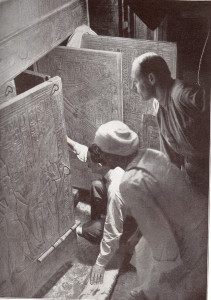Creatures of the Night: Mummies

Howard Carter (kneeling), an Egyptian workman, and Arthur Callender at doors of burial shrines in Pharao Tutankhamen’s tomb.
November 25 or 27, 1922
This is the second entry of Creatures of the Night: Season 2.
Halloween is the time of year where we allow ourselves to think outside of the norm and face those things that scare us most. In our look at the most terrifying Halloween creatures many come to mind that would instantly top the list of best movie monsters, like vampires, werewolves, and zombies. There is one classic creature that has been slightly forgotten in recent years, but is just as terrifying, especially considering the legends are based around very real deaths. The mummy is more than just a movie, and certainly more than just your average trick or treater wrapped in toilet paper. Rather, the mummy is a creature wrapped in the mysteries of time and cultures long past.
The most famous and strange legend of the mummy stems from the uncovering of King Tutankhamun’s – King Tut’s – tomb back in 1922. Many famous explorers and expeditioners set out in search for the tomb, and the explorers were rewarded with a once in a lifetime find. They found the remains of the boy king and his treasure and fascinated the world over.
However, not everything associated with the discovery was a success. 6 out of 26 people who witness the tomb being opened passed within a year, along with one of the top leaders and funders of the project. Thus, in the minds of many around the world was born the legend of the mummy’s curse.
Many have speculated as to what actually killed the explorers, but a popular belief is that all of the things left with the mummy during the embalming process might have produced some sort of pathogens that could have been deadly upon their release when the tomb was opened.
In ancient Egypt, the mummy was centered on the embalming process. Some of the first mummies were probably accidental. The sand and air in the Egyptian desert occassionally preserved bodies that were buried in shallow pits. Eventually, the preservation of the dead would be a purposeful act and would continue for nearly 2,000 years.
The process of making a mummy was a slow one, usually taking 70 days. Priests with throughout knowledge of human anatomy took part in the process. First they would remove all internal organs that would decay rapidly upon death. However, the Egyptians would leave the heart inside of the body, because they believed that the heart was the center of a person’s being and intelligence.
Secondly, those making the mummy would draw all moisture from the body by placing natural salts within and on the body. After this was over they would wrap the body in yards of linen strips, saying prayers and placing jewelry and other favored items with the body. This is where we get the idea to wrap ourselves in toilet paper to make our mummy costumes.
Eventually, these creatures would be forgotten and the Egyptians would find a new way to bury the dead. However, with the opening of King Tut’s tomb came the fascination of what the mummy could do. The imaginations of film makers began to run wild with the idea of the mummy coming back to life and seeking revenge on those who had done them wrong in their past life. Ancient Egypt has been closely identified with ancient curses ever since, even though cursed graves appear in cultures all over the world.
The mummy is a particularly terrifying creature because it cannot be fought. While modern films interpret the mummy as a shambling wrapped corpse, little more than a zombie, legends paint the mummy as the embodiment of the disdain that the dead hold for those who do not respect them. There is no running from a mummy’s curse: it will follow you until it’s work is done. So, be careful when you go traipsing through your local graveyards this Halloween.










